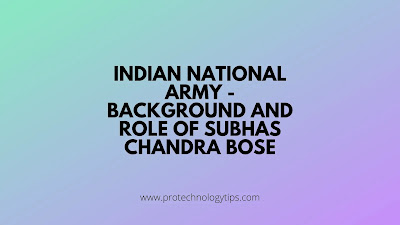In this article, we discuss the Indian National Army and its background and the role of Subhas Chandra Bose for various competitive exams such as UPSC, SSC, etc...
World War II started on 1 September 1939. Britain had colonies in many places in South East Asia like Philipines, Hong Kong, Malaya, Singapore, etc...
Because Britain and Japan were fighting against each other, these British colonies were at risk of being attacked by Japan. Therefore the British Government sent about 70,000 British Troops to these colonies.
On 3 September 1939, Lord Linlithgow gave a declaration without asking the Indian leadership where he said that India was supporting Britain in World War II.
There was anger in the whole country due to this declaration of the Viceroy. People used to say that they would have asked once upon the Indian politicians who had come in the elections of 1937.
In its protest, the Congress resigned with the Provincial Ministries. In its protest, Congress resigned with the Provincial Ministries. He demanded to launch the Civil Disobedience Movement in the Congress meeting.
Gandhiji was not agreeing with this. Subhash Chandra Bose thought that if not in the whole country, he can start a mass protest in Calcutta. He started a mass protest in Calcutta to remove the Hollwell Monument.
Hollwell was one of the very few people left in the Black Hole Incident. In memory of the Black Hole Incident, he built this monument with his own money.
The black Hole Incident was a very painful event. In this, 146 people were locked in a small room and 126 people died of suffocation in it.
The British Government had a strong emotional connection with the Hollwell Monument.
Subhash Chandra Bose was saying that remove this monument, the British government did not like this thing and they put Subhash Chandra Bose in jail.
Subhash Chandra Bose started a 7-day hunger strike in jail in which his health deteriorated. That's why the British government shifted them to their own house.
Surveillance of the police was kept around the house. That means, they were house arrested in their own house.
After this on 17 February 1941, Subhash Chandra Bose escaped by dodging the police in the guise of Pathan.
After leaving Calcutta, he reached Peshawar and then via NWFP to Afghanistan. From it, he reached Soviet Russia, and from Russia he reached Italy and finally reached Germany.
At that time, there were a lot of Indian shoulders in the Prisoners of war camp in Germany. These soldiers were soldiers of the British Army who were deployed in North Africa in World War II. The Axis Power, which also had Germany, had taken them captive.
Subhash Chandra Bose, with the help of the German authorities, gathered these Indian Presioners of War Soldiers and formed the Army so that this army put the British government out of India. This Army contains neary 4500 Soldiers.
Subhash Chandra Bose named this army Free Indian Legion. The German authorities were supporting Subhas Chandra Bose because there was an advantage in it as Germany and Hitler.
Britain and Germany were fighting against each other in World War II. If Subhash Chandra Bose attacked Britain by forming an army, then Germany also had an advantage in this.
In the meantime, some such things happened, after which Subhash Chandra Bose started doubting the intentions of Germany.
Those things were that Hitler wanted to Invade Russia and he had written his biography in such a way that he did not like Subhash Chandra Bose.
If Germany annexes Russia, then Indians will consider Germany as their enemy and not their friend.
Subhash Chandra Bose also felt that Germany would help in removing Britain from India, but it should happen that after that he would Invade India.
Subhash Chandra Bose thought that there is no point in wasting time in Germany, Japan is also fighting against Britain, so why not talk to him.
That's why Subhash Chandra Bose went to Japan by submarine in February 1943.
As we talked about before, the British government had sent Indian troops to the colonies of South East Asia. Among them was Mohan Singh, the head of the Malaya Peninsula's troupe.
Japan attacked the British colonies one after the other. In this attack, Japan had captured many soldiers of the British regiment, Mohan Singh was also in it.
Rash Behari Bose went to Japan after the Ghadar Movement failed in 1915. In Japan in 1942, Rash Behari Bose formed the Indian Independence League with the support of the Japanese government.
Their aim was to liberate India with the help of the Japanese government. He convinced the Japanese government to form an army under the Indian Independence League, which would liberate India from the British Army.
Japan also benefited from this because Britain would have been weakened by doing so. The idea was to form an army by gathering the captured Prisoners of War Indian soldiers in Malaya and other South East Asia.
Now the search was on for a general who could collect all these Prisoners of War Soldiers and prepare a military. The name of Mohan Singh came into his mind.
Rash Behari Bose, along with Japanese Major Fujihara, approached Mohan Singh. Mohan Singh started preparing to form the Indian National Army.
4000 Prisoners of War Soldiers were brought from Malaysia, 40,000 from Singapore, and other Soldiers from South East colonies. Mohan Singh was the general of this army.
This army is also called the First Indian National Army. But Mohan Singh felt that the Japanese only wanted to use the Indian National Army.
Due to this, many times there were disagreements with the Japanese leadership of Mohan Singh. Due to this, many times there were disagreements with the Japanese leadership of Mohan Singh.
On 29 December 1942, Mohan Singh was removed from command and handed over to the Japanese Military Force and the Indian National Army was disbanded.
The soldiers who were gathered were sent back to the Prisoners of War camp. When Subhas Chandra Bose reached Japan and again the idea of the Indian National Army is revived.
In 1943, a meeting was called in Singapore in July, in which Rash Behari Bose gave control of the Indian Independence League to Bose. Subhash Chandra Bose again strengthened the Indian National Army with his efforts.
Netaji's craze was so much that as soon as it came to know that Indian National Army would be led by Subhash Chandra Bose, then along with the Prisoners of War Soldiers, the civilians of south east asia is also joined the Indian National Army. He also supported Financially.
Subhash Chandra Bose had also created a women's unit in the Indian National Army whose name was Rani of Jhansi Regiment. Captain Lakshmi Swaminathan was leading this regiment.
For the first time in history, an all women's combat squad was created. There was no discrimination of any kind among the soldiers of the Indian National Army.
There were 4 brigades in the Indian National Army - Gandhi Brigade, Azad Brigade, Nehru Briged and Subhas Briged.
Subhash Chandra Bose also gave a powerful slogan - "Give me blood, And I shall give you freedom." We have also got this "Kadam kadam badhaye ja" song from the Indian National Army. We have got the "Jai Hind" salutation from Indian National Army.
Subhash Chandra Bose had also formed a provisional government named "Azad Hind Government". Indian National Army was the army of the Azad Hind Government.
The Azad Hind Government was the provisional government of India which was established in Singapore.
It also had its own currency notes, postage stamps, and your courts and laws. The Prime Minister of this government was Subhash Chandra Bose and there were also ministers.
This government was recognized by 9 countries like Germany, Japan, Italy, China, Burma, Philippines, Crusia and some other countries like the Government of India.
Azad Hind Government had diplomatic relations with these countries. The Azad Hind Government was running with the financial, military and political support of Japan itself.
In 1943, Japan captured the Andaman and Nicobar Islands and then gave the nominal authority of these regions to the Azad Hindi Government.
After the Azad Hind Government got these islands, they changed their names to Sahid and Swaraj.
Nominal authority means that the authority of this island is with the Indian National Army but it is still a little Japanese Soldiers. That means the entire authority was not with the Azad Hind Government.
After this, in April 1944, while fighting with the Imperial Japanese Army, the Indian National Army recorded its first victory on the Indian Soil. This victory was registered in Arakan, Nagaland and Manipur.
The Indian National Army had entered Kohima in Nagaland and Imphal in Manipur. The Indian National Army hoisted the Indian flag for the first time in Moirang, Manipur.
After this, the combined forces of the Japanese and the Indian National Army could not face the British Army and the Indian Front had to be abandoned.
In August 1945, news came that Netaji was killed in a plane crash.
If you like this article about Indian National Army, consider sharing this article with friends.









